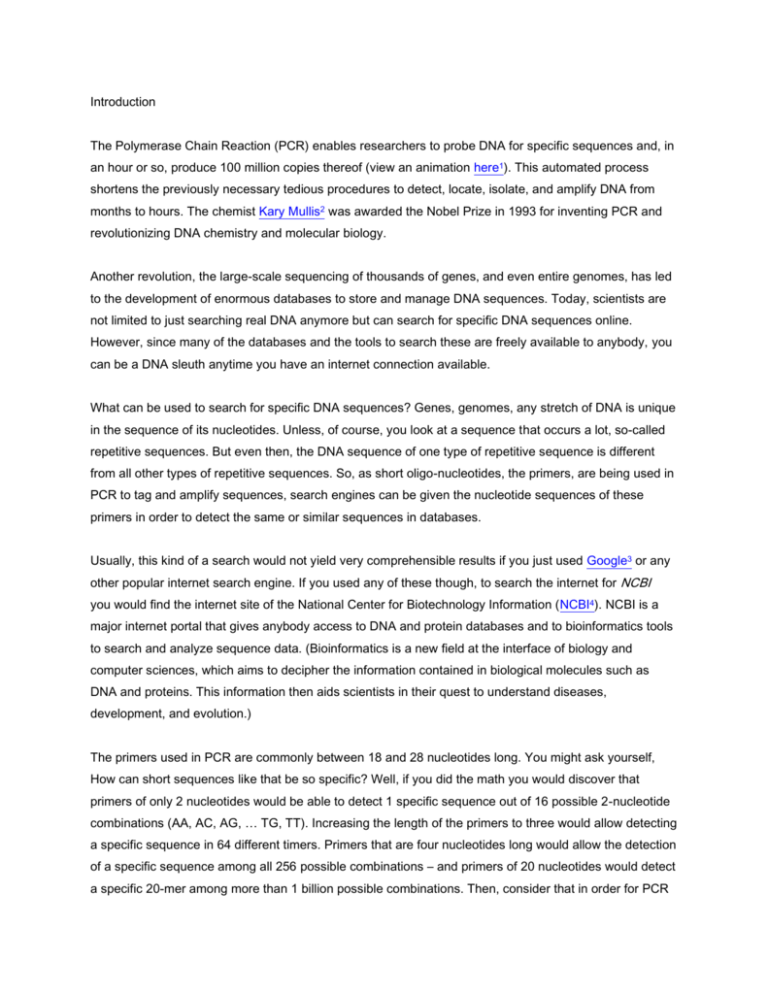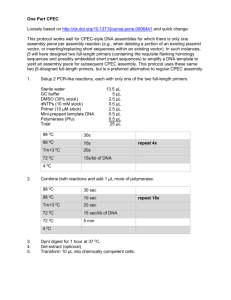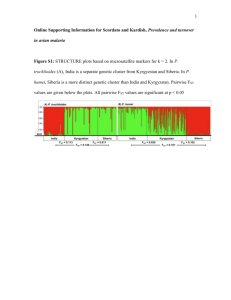The Polymerase Chain Reaction (PCR) enables researchers to
advertisement

Introduction
The Polymerase Chain Reaction (PCR) enables researchers to probe DNA for specific sequences and, in
an hour or so, produce 100 million copies thereof (view an animation here1). This automated process
shortens the previously necessary tedious procedures to detect, locate, isolate, and amplify DNA from
months to hours. The chemist Kary Mullis2 was awarded the Nobel Prize in 1993 for inventing PCR and
revolutionizing DNA chemistry and molecular biology.
Another revolution, the large-scale sequencing of thousands of genes, and even entire genomes, has led
to the development of enormous databases to store and manage DNA sequences. Today, scientists are
not limited to just searching real DNA anymore but can search for specific DNA sequences online.
However, since many of the databases and the tools to search these are freely available to anybody, you
can be a DNA sleuth anytime you have an internet connection available.
What can be used to search for specific DNA sequences? Genes, genomes, any stretch of DNA is unique
in the sequence of its nucleotides. Unless, of course, you look at a sequence that occurs a lot, so-called
repetitive sequences. But even then, the DNA sequence of one type of repetitive sequence is different
from all other types of repetitive sequences. So, as short oligo-nucleotides, the primers, are being used in
PCR to tag and amplify sequences, search engines can be given the nucleotide sequences of these
primers in order to detect the same or similar sequences in databases.
Usually, this kind of a search would not yield very comprehensible results if you just used Google3 or any
other popular internet search engine. If you used any of these though, to search the internet for NCBI
you would find the internet site of the National Center for Biotechnology Information (NCBI4). NCBI is a
major internet portal that gives anybody access to DNA and protein databases and to bioinformatics tools
to search and analyze sequence data. (Bioinformatics is a new field at the interface of biology and
computer sciences, which aims to decipher the information contained in biological molecules such as
DNA and proteins. This information then aids scientists in their quest to understand diseases,
development, and evolution.)
The primers used in PCR are commonly between 18 and 28 nucleotides long. You might ask yourself,
How can short sequences like that be so specific? Well, if you did the math you would discover that
primers of only 2 nucleotides would be able to detect 1 specific sequence out of 16 possible 2-nucleotide
combinations (AA, AC, AG, … TG, TT). Increasing the length of the primers to three would allow detecting
a specific sequence in 64 different timers. Primers that are four nucleotides long would allow the detection
of a specific sequence among all 256 possible combinations – and primers of 20 nucleotides would detect
a specific 20-mer among more than 1 billion possible combinations. Then, consider that in order for PCR
to work two primers are needed that match a target sequence in close proximity to each other and you
will understand that even sequences that consist of only 20 nucleotides make PCR-based DNA
amplification highly specific.
Exercises:
1) Finding DNA sequences using BLAST ('Electronic PCR')
Use the sequences of the PCR primers used in the GMO lab to "isolate" DNA from databases.
Perform BLAST searches (blastn) with the sequences of the primers used in the GMO testing experiment.
Analyze the results and determine a) the nature of the genes targeted by these primer sets, and b) the
size of the amplicons that you would expect by using these primers to PCR DNA from food sources.
Record your results in this worksheet, then save it or email it to yourself.
2) Genetically modified organisms (GMO's) worldwide?
The US have a leading role in the utilization of genetically modified crop plants.
Europe, on the other hand, had a significant role in the development of the techniques for the generation
of GMOs, but seems rather hesitant in implementing the new technology. Find out at the website of the
British National Center for Biotechnology Education, NCBE, which event in 1999 led to a downturn in the
acceptance of GMO foods by the European public.
3) Genes commonly used to alter plants
Genes are never transferred alone. They are parts of constructs, known as ‘expression cassettes’. Each
gene is sandwiched between a promoter, which signals the cell to turn the foreign gene on and a
terminator, to end the transcription and to mark the RNA, so it can be further processed and translated:
Promoter > Gene > Terminator
Typically, each bit of the construct: promoter, gene and terminator, is from a different source. Several
expression cassettes are usually linked into a final construct. At least one of them will contain an antibiotic
resistance gene to enable scientists to select cells that have taken up the construct with antibiotics.
Use bioinformatics to find genes that are transferred into food or fiber crops and determine their function.
Repeat the BLAST search with the 35S-primer pair you used in Slide 3 limiting your search from All
Organisms to Virus and Viridiplantae. Determine the nature of the genes driven by the 35S promotor by
following the gi links to the GenBank entries for some hits and identifying the genes that follow the 35S
promotors in the DNA sequence.
Learn more about traits modified in crop plants at this website of Cornell University.
Links
1
http://www.dnalc.org/shockwave/pcranwhole.html
2
http://nobelprize.org/chemistry/laureates/1993/mullis-lecture.html
http://www.google.com
3









